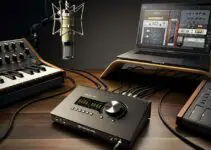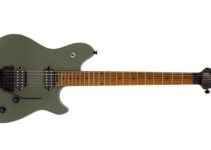Founded in 1965 by Hartley Peavey, Peavey Electronics Corporation is an American electronic company that designs, manufactures, develops, and markets professional audio equipment.
Peavey is a household name in the musical instruments world. As a matter of fact, it remains one of the largest audio equipment manufacturers in the world with its headquarters in Meridian, Mississippi. The company’s estimated worth is about US$271 million.
However, in the musical instrument world, especially the world of guitars and bass, many people only know Peavey as a manufacturer of amps, combos, and speaker cabinets. On the contrary, Peavey goes way beyond manufacturing amps and cabinets.
Peavey also manufactures top-class drum kits, electric guitars and bass guitars. The Radial Pro Series drum kits were Peavey’s high-end drum line. These high-end drum kits were in production from the year 1994 to 2002.
The series consisted of the RBS-1 prototypes, radial pro-1000, 750/751, and 500/501 models. Apart from drums, it is also a fact that Peavey also makes some very amazing bass guitars. One of those super amazing bass guitars is the Peavey T-40.
The Peavey T-40 bass guitar was one of Peavey’s first bass guitar designs ever made; it was popular for its affordability and solid construction. Although many would agree that the T-40 is quite heavy, very few would disagree that it is built like a tank and can withstand some mishandling.
In this article, we will review the Peavey T-40 bass guitar and subsequently tell you if it is worth its price, worth the hype or worth giving a try.
The Truth is that the Peavey T-40 is a solidly built bass guitar and many would agree with that. It features two superb Toaster-style pickups and two switches.
Above all, it is versatile and has quite an amazing tone that would fit different genres and styles.Considering the overall quality and playability and comparing it with other similarly priced brands, it is not out of place to say that the Peavey T-40 is truly a superb guitar and is worth every penny on its price tag.
Table of Contents
Peavey T-40 Electronics – Pickups, Knobs and Switches
What can we know about the electronics of an instrument, without opening it up or without having X-ray vision? We can look at the knobs and switches, which give us a lot of information about the underlying electronic components and what we can do with them.
You’ll see right away that the T-40 has 4 knobs and 2 switches. You have a volume-tone pair for each of the pickups, a pickup selector with three positions and a phase switch.
After seeing this, we can suppose that the T-40 has a lot of different options to play around with to create different sounds and experiment with various combinations, creating unique sounds and blending different pickup configurations.
Now let’s use our X-ray vision to see what each of these knobs and switches actually do.
Volume and Tone Knobs
The volume-tone pair is great, they control the volume of each of the pickups and the tone controls are coil switches, which means that the control is being used to switch between different coil configurations in the guitar’s pickups.
From 7 to 10 you are using a single coil pickup; below that, you are in ‘humbucker mode,’ which are essentially two single-coil pickups wired together, canceling the electromagnetic interference by inverting their polarities.
A coil switch (also known as a coil-split or coil tap) allows you to split the humbucker so it sounds more like a single coil pickup, which typically produces a thinner and brighter sound compared to a humbucker.
This gives the player more tonal options, as they can switch between the full, warm sound of a humbucker and the crisp, clear sound of a single coil. The signal that this bass outputs is pretty strong too. Amazing!
Pickup Selector Switch
The pickup selector chooses either pickup 1 alone, pickups 1 and 2 combined, or pickup 2 alone, giving you multiple options to find your desired sound. Next, let’s talk about the other switch.
Phase Switch
The phase switch swaps the ground and hot of one of the pickups, which changes the way the sound waves from the pickups interact with each other.
Using non-technical language, can you see how it starts at a neutral point, then peaks at the top, and then reverses and peaks at the bottom? The phase makes reference to the starting point of this cycle.
In this example, and in most common theoretical scenarios, the starting point is neutral, but if you change the phase, the wave can start at any other point of the cycle.
When you combine two waves (in this case the two waves are generated by the pickups, which added, make the final result of the sound) the phase of each of the waves – in relation to each other – has an effect on the ‘colour’ of the sound.
This might seem trivial at first sight, but take some time to try it and play around with it, you’ll find that this subtle change is audible, and a nice tool to add richness and variety to your bass sound.
If you’re having trouble perceiving what is the change, pay special attention to the attack. At this point, you can already see how special this bass is. You can hear a demo trying the different setups here:
We’ve covered what all the controls do, now let’s look at what are their limitations.
Limitations
Surprisingly, there is not a lot to say here, of course, leaving aside the fact that every individual has their own preferences and taste, which can’t really be explained rationally.
The pickups are of great quality and the amount of different sounds you can get is simply incredible. But let’s try to find some limitations anyway:
- Having too many controls (4 knobs and 2 switches) can be overwhelming. Some people just want a simpler experience. Too many choices can be confusing sometimes.
- The more controls, the more components can break. It’s just a numbers game, if you have 1 knob, the only thing you might have to eventually fix is 1 knob. If you have 4, the risk of breaking one of them is just higher.
Playability
Versatility and Tone
One of the standout features of the T-40 is its versatility. Users have noted that with its numerous knobs and switches, you can get this bass to sound like just about any other type of bass.
It has a very full and rounded tone with a fantastic treble edge when the tone is rolled all the way on. Roll the tone back a bit, and it maintains a very clear but deep note. Overall, it has an almost piano-like sound.
Comfort and Playability
Despite its weight, many players find the T-40 comfortable to play. The wide string spacing might require some adjustment, especially for beginners, but it’s not a deal-breaker for most players.
A Bass for Beginners or Professionals?
We’re safe to say that the T-40 is considered suitable for both beginners and professionals. Its versatility and durability make it a good choice for beginners who want a reliable instrument that can grow with them as they improve.
However, we would not exactly say that this is the best bass for a beginner looking to start learning bass. Simply because there are cheaper and simpler options out there that will get you started and give you all you need for the first year or two of your learning experience.
Professionals will definitely appreciate its solid construction and the range of tones it can produce. This is a legendary instrument that has earned its reputation throughout the years.
So if you’re a pro with many years of experience, no one’s going to really question you having a T-40. It just makes sense from all perspectives.
Limitations
- The neck is thicker and rounder than some other basses, but in most cases, you’ll get used to it. This also makes it less optimal for the beginner’s left hand, which might get fatigued quicker.
- It might not be the best option for young children either starting to play, because of the neck size.
Again, not a lot more to add here. You can already start to guess what our conclusion might look like.
Body Construction: What’s so special about the T-40’s body?
The body is typically made of Ash, which is a hardwood known for its resonance and durability. Although you can find variations, it usually has a Maple neck with a 20-fret Rosewood fingerboard.
The T-40’s body is usually described as large and heavy, giving it its distinctive tone and sustain. The word ‘solid’ comes to mind when describing it.
Also, this bass has a micro tilt adjustment for the neck which is used to fine-tune the neck’s angle relative to the body, customizing the action, (the distance between the strings and the fretboard).
Weight
If there’s one thing that every bass player that owned or played the T-40 remembers, it will be its weight, ranging from 12 to 14 pounds (approximately 6kg). And why is weight important?
Firstly, the weight of the instrument greatly impacts the comfort of the musician, whether playing at home or during live gigs. Secondly, because it obviously speaks of the materials and the build in general.
Also, the overall feel of an instrument influences how the musician plays and how the music flows. A big and heavy instrument will always feel significantly different from a light one.
You play differently depending on how your instrument feels. A heavy instrument kind of roots you down through your feet, you also need to hold it more tightly, creating this grip-like feeling.
Think also of playing a badass bass line with a very light instrument, there’s nothing wrong with it, but a heavier instrument will give a greater feeling of power.
These details and more actually influence your playing, either consciously or subconsciously. So there you go, for us, weight matters.
Limitations
Most of the limitations when considering buying a T-40 come from its weight:
- Heavy for musicians that have back problems or any condition that compromises the lifting of weight.
- If you’re on tour and need to carry the bass around, this bass might not be the most ideal.
- Not so comfortable to play while standing up and/or for extended periods of time.
That’s it, so if you are strong and have good resistance, you have nothing to worry about! – watch out for tendinitis, pay attention to the relaxation of your wrists.
T-40’s Price
Since this bass is no longer in fabrication (at least not in May – 2023), you can find used T-40s at different prices. The average price of a Peavey T-40 bass is approximately $1000, but it will depend on your location, the general state of the bass and several other factors.
There are lucky ones who found T-40s in remote music stores and paid less than half of that, so keep an eye open! Here’s a link where you can find some options in the US.
Final Verdict
As you might have gathered from the ‘limitations’ sections in this article, there aren’t many negatives to say about this bass. It is a testament to the craftsmanship and innovation that Peavey has been known for since its inception.
The diversity of sounds you can get is simply out of this world. From deep, resonant tones that shake the floor, to crisp, punchy highs that cut through the mix, this bass allows you to explore an exceptionally wide sonic palette.
The build is so strong and solid that it will easily last many years more than any other average bass, even if you’re not the most delicate musician when it comes to handling your instruments.
Ultimately, your final decision will hinge on your budget for your next bass guitar (and if you are badass enough to wield the formidable T-40); if a thousand dollars won’t hurt your bank account, then it’s definitely worth it having a T-40.
Especially if you have a thing for vintage (it’s not a modern bass, but modern doesn’t always beat old school). Something is for sure, if you own one, people will ask you about it, and they will want to take a closer look.
Finally, after reading this, we think that the best way to really know if the T-40 is for you, is to try it yourself, so go to your preferred music shop and play your favourite bass lines on it, see how it feels.
Afterall, the value of an instrument is in the happiness and satisfaction you get when you play it.


![Fender Super Champ x2 vs. Blues Jr [Tones, Features, Versatality, etc..]](https://performerlife.com/wp-content/uploads/2022/09/fender-super-champ-x2-vs-blues-jr-211x150.jpg)


